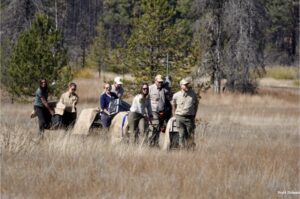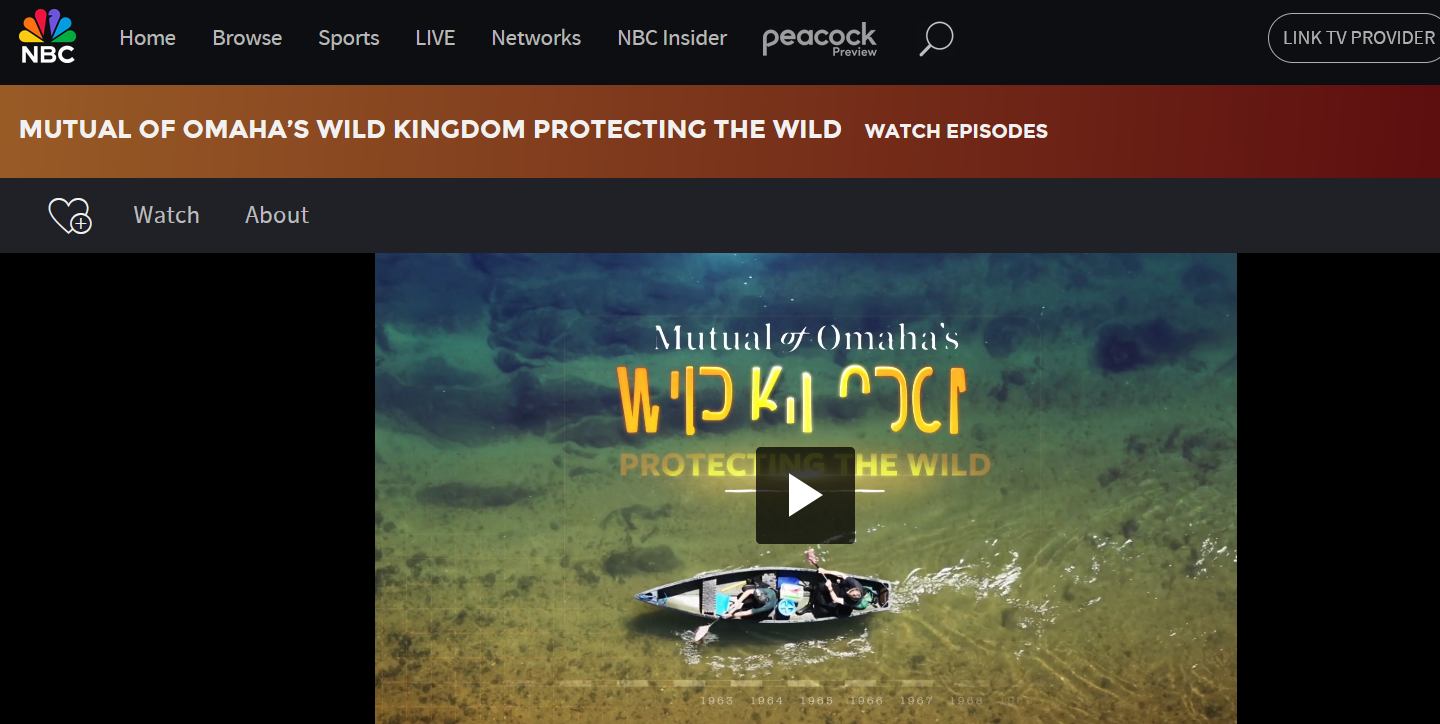All hail the good women and men of Orchard Park in Buffalo NY. They are marching in step to demand their city use smarter tools to coexist with beaver.I already wrote the city council and have made some friends in the area. Let’s just see how this goes.
Orchard Park grapples with dam-building beaversMonth: December 2023
Just in time for the holidays Wild Kingdom has finally released ‘their new beaver episode starring our favorites hrtord and lots of their friends you will recognize. Unfortunately I can’t embed the entire episode yet but this should whet your appetite:
Wasn’t that fun? To watch the full episode you have to go to the NBC site by clicking on this image.. I promise it’s worth the commercials.
Yesterday was he real deal. Proof positive that CDFW ha s finally changed its tune for good or for a while anyway, . Even my gloomy perspective was lightened. just ;look what happened:
CDFW Releases Beavers Into the Wild for First Time in Nearly 75 Years
Beaver Reintroduction Conducted in Cooperation with Local Tribes
Media Note: A link to download photos and video of the beaver release is available at the bottom of the news release.
The California Department of Fish and Wildlife (CDFW) has launched the initial phase of its beaver translocation activities, recently conducting the first beaver conservation release in nearly 75 years. Working with the Maidu Summit Consortium, CDFW released a family of seven beavers into Plumas County, in a location that is known to the tribal community as Tásmam Koyóm.
The new family group of beavers join a single resident beaver in the valley with the ultimate objective of re-establishing a breeding population that will maintain the mountain meadow ecosystem, its processes and the habitat it provides for numerous other species.
Humans have so admired the skilled work of beavers they have spent millions of dollars trying to replicate the benefits they create. Thanks to Governor Gavin Newsom’s leadership and the State Legislature for supporting that leadership with funding in the state budget, beaver restoration is now part of a larger effort to help mitigate the impacts of wildfires, climate change and drought.
Seven beavers. SEVEN I’m generally not very supportive of beaver relocation and it often doesn’t work out like you’d hope but SEVEN is respectable. That means they really took time to get the whole family. It means they didn’t do what was easy. They did what was right.
“Thanks to the leadership of our tribal partners and years of preparation, beavers are returning to their original homeland around the state,” said Governor Gavin Newsom. “California is restoring wildlife and critical habitat by working hand-in-hand with the tribes who have stewarded these lands.”
The historic release represents the first phase of CDFW’s North American beaver (Castor canadensis) restoration project, releasing beavers into the waters on the ancestral lands of the Mountain Maidu people. Soon to follow is a beaver reintroduction effort on the Tule River Reservation in the southern Sierra Nevada.
“Beavers help retain water on the landscape, which increases groundwater recharge, improves summer baseflows, extends seasonal flows and increases fuel moisture during wildfire season, effectively creating green belts that can serve as wildfire buffers or breaks and provide refugia for wildlife,” said CDFW Director Charlton H. Bonham, who joined the historic beaver release. “We look forward to duplicating these efforts on the Tule River Reservation in the southern Sierra Nevada mountains this spring.”
“This is the first time in decades our state agencies have reintroduced beaver into its original homelands with the leadership of our tribal partners at the Maidu Summit Consortium,” said California Natural Resource Agency Secretary Wade Crowfoot who also attended the beaver release. “Beaver relocation will help both to restore the environment and preserve traditional culture of our tribal partners who have stewarded these lands since time immemorial. I’m excited to watch how beaver will improve the health of landscapes in coming decades and support traditional lifeways for our diverse tribal communities.”
 Someone from OAEC shared some photos of the operation. I have no idea what endangered species the beavers were threatening in Sutter but we know hay county is in the top 3 od beaver trapping so I guess its better they have a chance.
Someone from OAEC shared some photos of the operation. I have no idea what endangered species the beavers were threatening in Sutter but we know hay county is in the top 3 od beaver trapping so I guess its better they have a chance.
The translocation follows multiple years of site preparation that ensured adequate beaver habitat that provides protection from predators and can support beaver population establishment. These preliminary efforts were conducted through Maidu Summit Consortium’s collaboration with the U.S. Fish and Wildlife Service, Occidental Arts & Ecology Center’s WATER Institute, Lassen National Forest, Plumas Corporation, Swift Water Design, Symbiotic Restoration, Feather River Land Trust, The Sierra Fund, CalPBR Network and several others.
“Getting to this moment of our first reintroduction really is a product of so much leadership from so many people. We would not be here without the Tule River Tribe of California who have been out front advocating for these actions for years, tribes around the state like Karuk, and, of course, Maidu Summit Consortium leaders. The future looks much better because of these leaders,” Bonham said.
 In alignment with CDFW’s new beaver depredation policy, the translocated beaver family was relocated from Sutter County, where their activity was damaging lands supporting several threatened or endangered species. To date, the entire family group, which consists of a breeding pair and their offspring, has survived. After exploring miles of habitat throughout the valley and locating the resident beaver’s territory, the family settled into the release area and has established shelter for the impending winter. The translocated beavers and receiving ecosystems will be monitored for multiple years following their release to assess the population, movement, habitat utilization, behavior and activity, potential conflicts, mortalities and the need for additional translocations, as well as the ecological changes that result from beaver engineering on the landscape.
In alignment with CDFW’s new beaver depredation policy, the translocated beaver family was relocated from Sutter County, where their activity was damaging lands supporting several threatened or endangered species. To date, the entire family group, which consists of a breeding pair and their offspring, has survived. After exploring miles of habitat throughout the valley and locating the resident beaver’s territory, the family settled into the release area and has established shelter for the impending winter. The translocated beavers and receiving ecosystems will be monitored for multiple years following their release to assess the population, movement, habitat utilization, behavior and activity, potential conflicts, mortalities and the need for additional translocations, as well as the ecological changes that result from beaver engineering on the landscape.
I’m so old I can remember when CDFW said that beaver weren’t native to Plumas county and didn’t belong to the landscape. I guess those days are gone for good, or for at least another century.
 I have said in the past that I believe there is some remote beaver screening room where the powers that be review breaking beaver news all around the world around the clock and when ever the stories start to get too positive or affirming they hit a button and suddenly release a cloud of doom stories to counteract any positive feeling people might be having about beaver. Of course it is picked up by a million other news outlets because bad news travels around the world and back while good news is still putting on its shoes.
I have said in the past that I believe there is some remote beaver screening room where the powers that be review breaking beaver news all around the world around the clock and when ever the stories start to get too positive or affirming they hit a button and suddenly release a cloud of doom stories to counteract any positive feeling people might be having about beaver. Of course it is picked up by a million other news outlets because bad news travels around the world and back while good news is still putting on its shoes.
This is the new iteration of that. I read it is all over the news this morning and I’m sure well hear more tomorrow. Brace yourselves.
Study suggests boosting beaver populations could have toxic consequences
Beavers are influential animals in ecosystems. These dam-building, tree-chewing rodents change streamflow with their wooden barriers and create rich wetland habitats by diverting water into soils near rivers. They help conserve water and improve biodiversity.
But a preliminary study by CU Boulder researchers suggests that beaver activities in the Western U.S. may exacerbate the spread of mercury-containing toxins in rivers and the surrounding habitats. Clifford Adamchak, a doctoral student in the Department of Ecology and Evolutionary Biology presented the team’s findings at the 2023 meeting of the American Geophysical Union in San Francisco.
Wha-a-a-t? You might be rubbing your eyes and asking yourselves. And well you might…Let Ph.D. candidate Adamchak explain it to you:
Beaver ponds, because they lack oxygen, are a hot spot for bacteria that can generate mercury-containing neurotoxins.
“A stream that flows smoothly with nothing stopping it would have very different biological chemical and geological processes than a stream that has cascading beaver dams and ponds,” said Adamchak. “Beaver activities also impact the surrounding landscape, because the animals forage for woody vegetation on land.”
Okay, stay with me here. When water flows down a hill without bumping into things it takes all the icky pollution with it. And when it just sits there, trapped by beaver dams, it can’t go away. It just settles there. Mocking us.
Human activities, including coal burning and mining, emit mercury into the atmosphere. The mineral then gets into lakes and streams through rain and snow. In water, chemical reactions and certain bacteria transform the mineral into methylmercury, a toxic organic compound that can build up in organisms and travel down the food chain. For example, when a bear eats a fish containing methylmercury, the neurotoxin will accumulate in the bear’s body. Studies have shown consuming large amounts of methylmercury-containing food can lead to mercury poisoning and nervous system damage in humans.
While atmospheric mercury levels in the Eastern U.S. have decreased over the years because of emission reduction efforts, the levels in the Western U.S., have remained constant or even slightly elevated.
????? Emission levels in California have INCREASED compared o the east coast? Really?? Aren’t we always saying how California is soo crazy for wanting electric cars and burning expensive gas and over regulating everything?
Adamchak and the team set off to investigate whether increased beaver activities—partly due to reintroduction efforts—have led to a rise in methylmercury levels in the Western U.S. water.
Over the past summer, Adamchak visited several beaver ponds in California and Colorado, taking more than 300 samples of water and sediment from the ponds and their surrounding environment. He found that the methylmercury levels in the water of beaver ponds were very low, whereas the levels in the sediment— the soil and sand at the bottom and around the ponds—were very high. This suggests that the toxins might be accumulating in the sediment, rather than the water.
You’;re kidding me right? The toxins are trapped in the sediment and not in the water and you think that’s a BAD thing? Are you planning on drinking that sediment any time soon?
In addition, Adamchak found that the sediment around the ponds, where water periodically submerges, had the highest methylmercury levels. This implies that beavers could spread the mercury-containing neurotoxin in the surrounding landscape.
Wait the areas around the pond that fluctuated above and below water were the worst? Tell me what beaver das fluctuate like that? Do you mean during storms when the dam washes out and the beavers have to make repairs? Or do you mean when dams are destroyed by humans? Beaver pond water level typically does not fluctuate. That’s kind of the point of the dam in the first place.
The research is still in its early stages, and Adamchak said it’s unclear to what degree methylmercury can affect the wetland ecosystem as a result of beaver activities. But researchers are concerned that as beavers move around the river corridor across their lifespans and abandon old ponds, more vegetation may grow in areas with high methylmercury concentrations in the soil and get passed on to organisms that feed on them.
Or you know they might create more settling places where the water distills toxins into the soil and then the plant life metabolizes it and breaks it down to things that are slightly easier to tolerate.
Fortunately, previous studies have shown beaver ponds tend to have higher methylmercury concentrations when they are new, and the levels decrease significantly with age. “That suggests beavers probably don’t have overwhelmingly negative effects on the ecosystem. But at this point it’s very hard to say if more beaver activities are good or bad in terms of mercury levels,” Adamchak said.
Talk about burying the lead, Well things get better when you’re around so I GUESS that means you aren’t outright ruining them but the jury is still out. Just because things are better when you’re hear doesn’t mean you aren’t toxic.
Adamchak planned to revisit these ponds next year to collect more data. H e will also investigate if the age of the ponds or seasons influence the methylmercury levels in the ponds.
 Never mind investigating silly things like season or stream flow. If there is mercury in these ponds I’m SURE it’s the beavers fault. I mean didn’t hatters famously go crazy from using mercury? And didn’t beavers once dominate the hat industry? There;s the obvious connection.. Clearly they brought all that mercury with the into our streams in the first place.
Never mind investigating silly things like season or stream flow. If there is mercury in these ponds I’m SURE it’s the beavers fault. I mean didn’t hatters famously go crazy from using mercury? And didn’t beavers once dominate the hat industry? There;s the obvious connection.. Clearly they brought all that mercury with the into our streams in the first place.
Allow me to observe that CU Boulder is the same campus that produced famed beaver researcher Emily Fairfax. Her dynamic work in the past 5 years must have made a lot of researchers jealous and turned the tide for beavers in lots of ways. I guess somewhere in the Ivory tower on a boulder is a bitter professor saying “i could sponsor a PhD candidate and they will make the world HATE those stupid beavers, You’ll see.”
Adamchak himself hails from Davis where they are not big fans of beavers generally. I guess the whole absurd notion makes a kind of sense. Of course in California streams we have lots and lots of arsenic too left over from all the mine tailings from the gold rush. We are kind of glad that settles in the soil instead of the water.
Don’t you think?
Belleville has battled for years to resolve it’s pesky beaver problem and its even more pesky public problem sine there are more and more people in the area who co not approve of killing animals to solve problems. Our friend Doug has worked heroically to change their minds and they staunchly defending their ignorance.
Beaver trapping will continue to prevent flooding
Belleville city council has rejected a call
by Quinte Field Naturalists to eliminate trapping and euthanization of nuisance animals threatening infrastructure and homes in the city limits.
Council agreed to receive an annual report on animal trapping Monday from Joe Reid, general manager of Transportation and Operations, which recommended a 2019 policy that allows trapping of nuisance animals continue to be carried out only when it is unavoidable by city staff.
“The city is committed to having high standards of animal welfare within its municipal boundaries, including the humane treatment of wildlife; while respecting its statutory duty to protect residents, municipal infrastructure, and private property when culverts are being blocked or damaged,” Reid informed city council in his report.
Coun. Chris Malette, chair of the city’s Green Task Force, said it was unfortunate that trapping must be conducted in areas where culverts are blocked, for example, by beavers but lauded Reid for moving to have his staff plan on undertaking a BeaverCorps Professional Training Program from the Beaver Institute in 2024.
Yes of course we realize this didn’t solve the problem last time but we DEMAND the right to do it again anyway, We are the ones in charge and if we want to fail publicly over and over again you can’t stop us!
Malette said two of the devices are in place now in the city at present.
“Unfortunately for the folks at Quinte Field Naturalists, we can’t support their request to remove trapping from our policy, we just feel that it would just tie the hands of staff. We are not prepared to do that,” he said.
Reid told council, “our staff do make every effort possible to safeguard the co-existence within our community. Our staff do have a lot of efforts around putting up fencing around trees allowing them [animals] to do their thing.”
We want our
We want our
We want our right to trappppppp








































